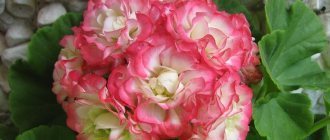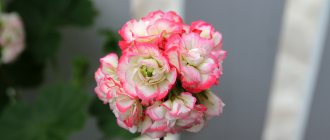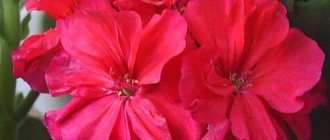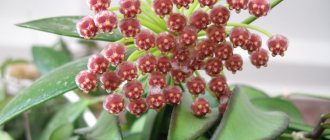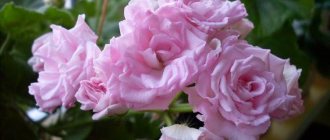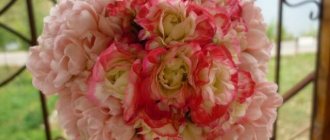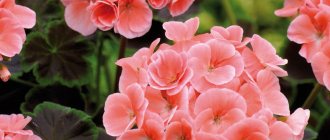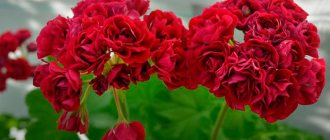Pelargonium Rosebud stands out for its special beauty. The plant was brought to Europe from southern Africa. Back in the 18th century, rosebud geranium became widely known. Botanists know about the existence of 250 varieties of this plant.
The flower belongs to the zonal pelargoniums. A large number of species have now been bred, but they all have common features:
- the flower has a distinct double appearance;
- the buds have a large number of petals, which do not fully open when flowering.
Rosebud geranium is an indoor plant. However, it can be grown outside if done only during the warmer months. The height of the bush in different varieties ranges from 0.5 to 1 meter. Leaf plates in different cases can have different shapes.
This plant does not require complex care and has beautiful flowers, but does not tolerate direct sunlight, high humidity and frost.
Growing rules
Caring for pelargonium and the process of its propagation at home is not particularly difficult. If your flower specimen is planted in a pot, its watering should be moderate. From time to time, the plant must be shaded so that direct sunlight does not cause burns. To irrigate the substrate, use water at room temperature.
Flower passion.
I love all living plants. I see a highlight in each of them. But my strongest flower passion in recent years has been pelargoniums.
Dear readers, at the moment I have a small but amazingly beautiful collection of unusually blooming pelargoniums. I have “Rosebud” - pelargoniums blooming with roses, Tulip - blooming with tulips, asters, carnations, one variety - peonies. There are several fragrant varieties, with the scent of rose, lemon, wormwood, peach, and apple. And I want to share all this wealth with you.
Terms of sale of pelargoniums 2022
Sales all year round, subject to delivery by a transport company, by bus, I arrange it myself. To the order amount you need to add approximately 400 rubles for transportation and packaging. I don’t send pelargoniums by mail because they don’t arrive well, then they get sick for a long time and, as a rule, they don’t survive.
My email address
Viber and WhatsApp tel.
1. Pelargoniums of the Rosebud series and Rosaceae
Apple Blossom Rosebud is a rosaceous zonal pelargonium. The plant is very large and fast growing. It requires the initial formation of the bush, and then it will show all the beauty and harmony of flowering. Loves very “fat” soil. Last year I fed them with liquid fertilizers for the flowering ones, but this year I just planted them in “humus” in the spring. The variety blooms very profusely, begins early in the spring and, probably, if not pruned in the fall, will bloom into the winter. This photo is fresh from autumn, I published it only because of its good quality, it does not reflect the true beauty of the variety. In summer the hats are much larger and denser. I especially admire roses - large white ones with a green center and pink edging of delicate petals.
2. Pelargoniums of the Tulip series, blooming tulips
Varieties of indoor plants
Geranium varieties are distinguished by their lush flowering and a wide palette of colors. Not only flowers, but also leaf blades of some varieties can have a decorative appearance.
A huge number of rosebund pelargoniums have been bred
- Rose of Amsterdam
"Rose of Amsterdam" is one of the miniature, fast-growing varieties. Terry inflorescences are painted in white and pink shades. As the plant ages, the buds become more and more vibrant.
- Supreme
"Rosebud Supreme" is distinguished by rich crimson, densely double flowers with white undersides of the petals. Under proper conditions, flowering can continue year-round.
For reference! Supreme typically enters the flowering season later than similar varieties.
- Apple Blossom
"Apple Blossom Rosebud" is one of the oldest varieties of pelargonium. It has, as the name suggests, a delicate apple green coloration with a rich pink edging.
The variety is quite whimsical and requires shading, frequent fertilization and pruning.
- Vectis
“Vectis Rosebud” is a miniature zonal variety with large wine-red buds and a light underside of the petals. Lush, disheveled inflorescences last a long time. The leaves are dark green.
- Red pelargonium "Rosebud Red"
Pelargonium Rosebud Red with deep red flowers. The inflorescences are densely packed and form almost continuously throughout the year. Does not require molding.
- Beverly park
Pelargonium with double, apricot-colored buds with a lighter, almost white edging. The leaf blades are green, darkening towards the central part.
For reference! Beverly Park - suitable for those who prefer a non-standard red color scheme.
- Princess Mary
Compact early flowering variety. The leaves are uniform green. The inflorescences are dense, greenish-white. As they fade, the petals turn pink.
- Rushmoor Golden Rosebud
Rushmoor Gold features bright pink flowers that are not too densely packed. The leaf blades are light, golden-green in color.
Varieties
Pink pelargonium blooms very beautifully, not inferior even to the rose itself. But if you want to include a similar specimen in your home collection, you should take a closer look at studying its most popular varieties. There are many of them, and they all have their merits. Let's find out which varieties of rosebud pelargonium are worth having in your home, and, if desired, in your personal plot.
Vectis rosebud
This shrub looks miniature, even when mature. You can safely grow it even if you are just getting acquainted with this group of plants. The Vectis rosebud variety does not need to be shaped. Among its key advantages is a long flowering phase. The mini-buds have a bright red hue, but the outer side of the petals in this case is slightly lighter.
Pink rambler
The geranium variety called Pink Rambler is considered one of the most popular in this category. If you want to have a very lush shrub with decorative corrugated leaves in your home, you should definitely think about planting this flower. The buds of this flower specimen are bright pink, and the shape of the petals is quite unusual. In this case, the front side of the petal is painted in a lighter shade.
Bornholm
Those flower growers who decide to root this attractive specimen at home should remember that its buds open very, very slowly. However, the not too high growth rate is more than compensated by the beautiful and rather lush flowering. The buds have a bright red hue, and their texture resembles satin.
However, when this happens, the petals do not fall off for a long time. Do not underestimate the foliage of this green specimen. They have a rich green hue, and each leaf plate has a mesh pattern.
Vit rosen
If Red Pelargonium or Pink Rosebud are not the only specimens you intend to include in your home collection, you should consider purchasing a Vit rosen flower. What is primarily remarkable about this variety is its buds with soft white petals, which have a muted green tone at the base. The flowers are formed double.
Arctic snow
If the previous flower specimen had white petals with a greenish tint, in this case the geranium buds have a pure white color. However, there is a key difference: the petals of such a plant are not double, but star-shaped.
Such a specimen will look very unusual. Moreover, some representatives of this variety are additionally covered with light stripes, which beautifully set off the base color.
Black pearl
This flower specimen belongs to the group of zonal plants. Its buds have a rich crimson hue. Immediately after the buds open, this pelargonium’s main color is burgundy, but over time it “fades” and becomes crimson. Another key characteristic of this variety is that it is considered fastidious in care (just look at the process of forming a shrub). However, the result will be worth the effort.
Varieties - description, photo
There are many varieties of flowers and it is difficult to choose the most beautiful ones. We list several popular and sought-after types.
Appleblossom rosebud
Apple blossom rosebud is a magnificent variety of multi-colored geranium, considered one of the oldest and most popular varieties. The inflorescences of the flower resemble bouquets of small roses: the core has a green-white tint, and the edges of the petals have a pink edging. The flower grows quickly and therefore needs regular pruning.
Denise
This species is considered a favorite among gardeners. A variety with densely double peach-colored flowers and a pink border along the edge of the petals. Despite the fact that the bush is medium in size, pruning must be done regularly.
Anita
This is an amazing variety that does not require special attention or regular pruning. The flower is very compact and does not grow more than 40-50 centimeters. The flower buds have a soft pink tint and slightly corrugated leaf plates. The petals have a round shape, collected in dense buds and inflorescences.
Pac viva Rosita
One of the most popular varieties for growing at home. Each inflorescence has approximately 15 buds. But to obtain lush flowering, the plant requires careful care. Regular feeding and watering will help to form double buds.
Features of reproduction
To propagate rosebud geranium, the seed method and cuttings are used.
Seminal
- Wrap the planting material in damp gauze. Leave it for 7-10 days in a room where there is no dry air. During this time, monitor the moisture content of the fabric.
- When the seeds swell, transplant them into the prepared substrate. Cover the container with polyethylene and water the soil regularly.
- As soon as a sprout appears and 4 leaves grow on it, the film can be removed and the plants can be planted in separate pots.
- The grown plant is placed in a container of suitable volume. It is better to use a clay pot, as this material allows air to pass through better. Drainage laid in a layer of 3 cm will prevent rotting of the root system.
Cuttings
Geranium cuttings can be carried out throughout the year, but the best time is from March to July. Procedure:
Cut a semi-lignified cutting from the mother plant, which will have 3-5 internodes, since the green and grassy one will not take root. Use only purchased soil, adding vermiculite to it. Pour the nutrient mixture into transparent plastic cups and plant the prepared cuttings
Preparation of planting material includes cutting, removing leaves and air drying for 30-40 minutes
In the first days, water carefully so as not to overwater or overdry. Rooting of cuttings occurs under lamps for 2-3 weeks
As soon as the first roots form, you can add more fertile soil... The familiar geranium, this unpretentious and incredibly beautiful flower, is famous for its most amazing variety of species and varieties.
How to choose what to plant in the garden or on the windowsill? Our articles will help you navigate. From them you can learn about the perennial Peony and the annual Robert, about Rosanna, which blooms all summer, about hybrids of the Angel variety and the interesting Plenum geranium, read what is good about Max Fry, how to care for the fragrant Lemon and fragrant, how to grow black geranium.
The familiar geranium, this unpretentious and incredibly beautiful flower, is famous for its most amazing variety of species and varieties. How to choose what to plant in the garden or on the windowsill? Our articles will help you navigate. From them you can learn about the perennial Peony and the annual Robert, about Rosanna, which blooms all summer, about hybrids of the Angel variety and the interesting Plenum geranium, read what is good about Max Fry, how to care for the fragrant Lemon and fragrant, how to grow black geranium.
Features of plant flowering
Without its luxurious inflorescences, geranium looks unattractive. You can achieve abundant flowering from it by providing suitable conditions.
Typically, pelargonium blooms in spring and summer. With the onset of the autumn-winter period, only those plants for which the optimal lighting regime has been created will bloom. When kept on a southern or western window, the inflorescences may not leave the bush throughout the summer. But it is worth considering that without proper rest they will gradually become smaller, less lush and bright.
In appearance, the inflorescences and the flowers of rosebud geranium themselves may differ depending on what varieties and species were used when breeding this particular plant. The buds of some hybrids are very dense and most similar to roses, like those of red rosebud pelargonium. In other varieties, the buds may be more disheveled and loose.
Proper pruning
Reference
Pruning should be done with extreme caution - the flower does not really like it. In order not to cause damage to the plant during this work, you need to know simple rules:
In order not to cause damage to the plant during this work, you need to know simple rules:
- The first pruning should be done only after the final rooting of Denise’s pelargonium.
- When pruning, use a sharp and disinfected tool.
- Pinching should be done only after the growth of young shoots - in this case, lateral branching occurs faster.
In the autumn, after flowering, it is necessary to remove those branches that are sick, too weak or withered.
Rules of care
Pelargonium blooms amazingly beautifully. But in order for this plant to delight you with the variety of blossoming buds, you need to competently approach the implementation of the most important agricultural techniques. Home care primarily includes moderate watering and protection from direct sunlight.
Neglect such recommendations, and the leaf blade will fade, the shrub itself will not look very lush and aesthetically pleasing, and the intensity of flowering will noticeably decrease
It is very important to properly moisten the plant substrate. If we are talking about home pelargonium, it is necessary not to overdo it with soil irrigation
Be sure to check the soil moisture level. Test the soil with your finger - if there is still soil on it, you can wait a little with watering. Otherwise, proceed to moisten the substrate.
However, take into account the fact that prolonged severe frosts are not the best conditions for wintering a plant. It is advisable that temperatures do not fall below +10 °C
In this case, pelargonium will wait until next spring without any problems.
On warm April days, you can finally start replanting pelargonium. You can’t do without it, since the soil composition will need to be updated at least once a year. Firstly, it will be replenished with a variety of nutritional components, and secondly, it will be quite breathable.
Soil can be purchased at a specialty store. However, many gardeners prefer to combine the necessary components themselves. To prepare the substrate, mix turf soil, peat, coarse sand, perlite, and humus. In the future, all that is required of you as part of caring for rosebud pelargonium is to moisten the substrate in time, after replanting, trim off old shoots, and add complex fertilizers to the soil several times a season.
Plant characteristics
Pelargonium Apple Blossom Rosebud
Pelargonium is one of the varieties of geranium; it belongs to the rose-type category, which more and more gardeners want to grow at home. The varietal characteristics of shrubs are their compact size and buds that have no aroma. The height of the bushes varies from 60 to 80 cm. The crop is also valued for its unpretentiousness in maintenance.
Something to remember! Preferring rosebud varieties of garden pelargonium, there is a need to renew the plants no later than after 5 years, because over time they lose their varietal characteristics, their splendor decreases, and the formation of inflorescences becomes less intense.
In order for a culture to delight with abundant and lush color, proper maintenance is necessary. First of all, it is necessary to provide moderate moisture to the soil and hide the plant from direct sunlight. If basic recommendations are violated, the leafy part will turn pale, and the bush will lose its lushness and bright aesthetic appearance.
The plant does not tolerate prolonged cold and frost. The best temperature for pelargonium is considered to be 10 degrees above 0. In such conditions, the bushes will be able to survive the winter without damage. It is considered mandatory to update the soil composition annually. You can periodically change your habitat. All this is needed to enrich the soil with various nutrients and microelements, and the soil also needs to be saturated with oxygen.
The best soil mixture for a plant is considered to be a substrate mixture:
- From turf land;
- Peat;
- Coarse sand;
- Perlite;
- Humus.
When replanting plants, you need not only to change the soil, but also to renew the bushes by cutting off old branches. It is also important to apply complex mineral fertilizers several times a season.
Fertilizing with mineral fertilizers
Secrets of caring for pelargonium rosebud at home
Simple rules will help you maintain your own beauty.
Lighting
And although the plant is light-loving, it should not be exposed to direct sunlight. Because of this, the leaves and stems will begin to turn yellow and wither, and the amount of water consumed will not be enough for normal life.
Therefore, choose a well-lit place, but darken it with a special covering for the window or build a fabric flooring. This way the geranium will receive a sufficient amount of light, but burns will not appear on it, spoiling the appearance and health of the geranium.
Humidity
Culture is not demanding of this factor. To ensure that the air humidity is sufficient, you only need to regularly ventilate the room in which the flower is located.
Requirements for soil and flower pot
Soil for royal geranium can be purchased in specialized stores or made independently. If you don’t want to go through the hassle of cooking, then buy the most common product with an acidity level of 5.6 to 6.5 (neutral position).
Or mix turf soil, humus, peat, perlite and sand (coarse) in the following proportions: 4:2:2:1:1. Pelargonium will feel great in it.
Rules and frequency of watering
Frequent watering is not good for geraniums. It may begin to rot, which leads to its premature death. Therefore, moisten the soil as needed, and not based on some system. Check the soil regularly for moisture. When you feel that there is liquid, there is no need to water the bush. If the soil crumbles and does not leave a mark on your fingers, then the plant needs the procedure.
Feeding
The plant requires a lot of strength before and during flowering. Therefore, experienced experts advise starting to use special fertilizers.
In the spring, mineral baits are perfect. They need to be added once every 2-3 weeks, their quantity is calculated individually. When the buds begin to form, turn on phosphorus-potassium products. In early fall, begin phasing out additional treatments to allow the plant to prepare for hibernation.
Disease prevention and pest protection
Have you noticed that the leaves have begun to wither and dry out more intensely? Try to slightly increase the volume of water for watering, as this is the first reason for yellow leaves. And move the pot away from the radiator; apparently, the air in the room has become too dry. Yellow lower leaves indicate insufficient lighting.
The overwatered root system responds with lethargy of the entire flower. The leaves also lose their color. If the flowers are actively drying out, then there is a high probability that the body has been infected by a fungus. Try treatment with 5% Bordeaux mixture. And treat twice (with a break of a week) with the special drug Fitosporin.
Diseases of a bacterial nature appear in the form of brown geometric spots
It helps to transplant into a different soil, only morning watering and the use of special chemical fungicides. The same method is also suitable for viral infections, but you should pay attention to the presence of insects. Be sure to find them and destroy them, because they are the source of diseases. Spray the leaves with a solution of pharmaceutical aspirin (1.25 tablets per 10 liters of water)
Rust on the leaves, the appearance of white fluff and gray spots, brown areas on the stems - all these symptoms indicate the presence of fungus. Destroy it using special means, reseed the soil to clear it of rotten parts of the plant and other debris, loosen it thoroughly and eliminate fertilizers containing nitrogen
Be sure to carefully tear off rotting areas
Major diseases
Like all plants, pelargonium can get sick. Plants may also suffer from pest attacks. Problems encountered when growing pelargoniums:
- Wilted leaves are a sign of high temperature and insufficient watering;
- Changes in foliage color - excess moisture and insufficient lighting;
- Spots on leaves are a sign of viral infections;
- Drying inflorescences are a sign of fungus;
- Gray rot.
Any problem can be eliminated by treating with chemicals or by ensuring proper maintenance conditions.
Features of care
Flower growers need to take into account that rosebud varieties are more demanding and capricious than representatives of other related varieties. In order for rosebuds to delight you with their chic blooming appearance, you need to follow the basic requirements and rules of care.
Lighting
Garden pelargoniums are more tolerant of the sun and feel great in open ground, but only in the warm season. Temperatures below +10°C will no longer be comfortable for the plant.
Watering
Pelargoniums love water, but overwatering can make them sick. Moderate watering with warm, settled water in reasonable quantities is suitable. To prevent overwatering, you need to inspect the soil under the bush and check whether another watering is needed or if you should wait a little longer.
For indoor pelargoniums, it is important to carry out hygiene procedures. You need to spray them with water weekly or give them a shower, after which you must blot the leaves with a cloth.
In winter, the flowers rest. They practically do not grow and can shed their leaves. While the plant is resting, there is no need to feed it, water it very rarely and try not to disturb it.
Feeding
After “hibernation” in the spring, the plant actively begins its vegetative activity. It grows and requires nutrition. Complex mineral fertilizers are used for it. They can be used several times a week
For flowering and bud development, you should pay attention to preparations with a high content of potassium and phosphorus
Reproduction
Rosebud pelargoniums reproduce only by cuttings. Despite the formation of seeds, they do not inherit the varietal characteristics of the mother plant. Seeds are used only by breeders to develop new varieties.
Although you can cut pelargoniums at any time, it is better to do this during their maximum activation. This is between March and July. Semi-lignified cuttings, which are under no circumstances green, should be cut from the mother plant. Each cutting should have from 3 to 5 internodes. Almost all the leaves will need to be removed, leaving only the petioles with a small piece of leaf. The cut will need to be dried in the open air for about 30-50 minutes.
Since freshly cut cuttings are vulnerable to harmful microorganisms, gardeners advise the following:
- Plant new cuttings in a substrate of 1 part special soil and 1 part vermiculite;
- Disinfect containers for seedlings before planting;
- Watering the cuttings should be regular and moderate;
The cuttings will take root within 3-4 weeks.
Transfer
Pelargoniums growing in pots grow quickly and need regular replanting.
This is best done in the spring, and it is important to do this before the period of active growth. You need to replant into a pot whose diameter is several centimeters wider than the previous one.
The soil must be permeable to air and contain enough nutrients. An excellent option is considered to be:
- 4 parts of turf land;
- 2 parts humus;
- 2 parts peat;
- 1 part river sand;
- 1 part perlite.
You can also use ready-made soil from the store. She should have a neutral reaction.
After transplanting, pelargonium should be watered and ensure that the soil has moderate moisture for several days. The appearance of new shoots will indicate successful rooting and acclimatization to fresh soil. The plant can then be pruned, formed into a bush and stimulated to bloom.
Rooting cuttings of rosebud pelargonium
Rosebud propagation occurs both by seeds and cuttings. The question of whether pelargonium reproduces by seeds is affirmative, but in this case, the plant will not inherit its parental qualities. It is better to learn how to take pelargonium cuttings than to risk failure in the future. The most suitable time for this process is the beginning of autumn and the end of summer, namely March-April, August-September. Although there are no special restrictions, pelargoniums can be rooted almost all year round. For winter, this process is somewhat more complicated, as for summer, due to the nature of the plant’s hibernation and flowering in the summer.
At the beginning, you need to make sure that the rosebud is not overfed with fertilizers and that the soil is well moistened. Then select a cutting with two internodes (more is possible), the length should not be less than five centimeters. If you choose a weak herbaceous cutting, this can lead to rotting of the plant. It is cut with a sharp sterile blade, all unnecessary (stipules, peduncles, leaves) is removed. It is necessary to dry the cuttings for one hour.
The next equally important step is soil preparation. There is a certain composition, which includes: river sand, soil and peat tablets. Before planting, it is necessary to treat plant sections with a special product, depending on the time of year.
Care should be taken to ensure that the peat tablets or prepared soil contain planting holes where the plant is located. It is then placed in a plastic cup. Near the cuttings you can lightly compact the peat. Watering is moderate, use little water, pour along the edge of the glass. Then the cups with the cuttings are placed in a bright place where direct sunlight does not penetrate. The rooting period can last up to one and a half months, depending on the type of pelargonium. If, after all, this process occurs in late autumn or early winter, it is better to first ensure that they have enough lighting (use additional lighting lamps). The optimal temperature is considered to be up to twenty degrees. There is no need to cover them with anything.
As soon as the emerging roots become visible, you can think about transplanting them from the tablet into glasses. For those cuttings whose roots are not visible, you need to cut off the mesh. After another week, the roots will already be clearly visible in the glass, at which point it will be possible to transplant the plant into a pot. This is just one of the options: how to root pelargonium, in fact, you can try different means and methods and choose the most suitable one for yourself. When planting, pelargonium rosebud seeds should be placed at a distance of at least five centimeters from each other and adhere to the temperature and humidity conditions. It is necessary to wait for at least two leaves to appear on the new plant in order to replant it in special containers.
At this time, the propagation of pelargonium, the breeding of pelargonium, which breeders are engaged in, has made it possible to develop a hybrid of a zonal and ivy-leaved plant, the so-called Ivy hybrid. Their main advantage is a short stem and a larger flower.
Characteristics of species and varieties
Several intraspecific groups can grow at home:
- The ampelous type has a creeping stem that does not grow upward. Features cascading foliage. An ivy-shaped plant that hangs down and is used to decorate the garden;
- The zonal species is distinguished by its endurance. Its height reaches 80 cm. The foliage of the species is dark, with a smooth transition to light colors. The fluffiness of the leaves is considered a special feature. The most popular variety that is not planted in open ground. The plant, although hardy, is still demanding;
- The dwarf (miniature) species is distinguished by its compact bushes. There is no need for forming. This variety is preferred to be grown not only in open ground, but also in limited areas. Flowers look very impressive in small pots, since the flowering is abundant and small lush bushes are formed. The plant is relatively picky in its maintenance.
Each of these subspecies has many different varieties, which differ in color, bud shape and content characteristics. The most popular are the rosebud pelargonium variety Red Scarlet, Rosebud supreme, Arctic, Snow and many others.
Rosebud variety Red Scarlet
It is necessary to consider the description of popular varieties:
- Vectis rosebud is a small-looking, mature bush that looks attractive. A good option for shaping. The main advantage is the abundant, long-lasting flowering. The bud is bright red. The inside of flower petals is darker than the outside;
- Pelargonium Rosebud Supreme - blooms with bright crimson, thick, double buds. The bud turned inside out has a different color scheme. The underside of the bud is white, which looks unusual. The bushes are straight and strong. The inflorescences of Rosebud Supreme Pelargonium are dense, bloom for a long time, and with proper care, flowering can be extended throughout the year;
- Pink rambler is one of the popular varieties. A bright and lush bush with corrugated leaves. Flower bud of bright pink color with red impurities. The front side is lighter;
- Margaretha pelargonium is a variety of royal geraniums used exclusively for decorative purposes. The blooms are arranged in several rows, which in appearance resemble small bouquets of unopened roses. The foliage has curly outlines resembling a border. The height depends on the location and can reach 80 centimeters;
- Red pelargonium Rosebud red is a plant with red double inflorescences. It has long and abundant flowering. The inflorescences themselves are thick, lush, dense. There is no need to form bushes. Optimal temperature for growing: 25 degrees in summer, from 15 to 20 degrees in winter. The flower is grown indoors;
- Pelargonium baby rosebud is a compact plant. The buds are red, with a faint crimson tint, white in the middle. The leaves are inconspicuous, of normal shape;
- Beverly park pelargonium is distinguished by large flower buds, double, apricot color. At the edges the color of the inflorescences is lighter. The leaves are green, darkening towards the center.
On a note. Regardless of the chosen species and variety: Pelargonium Rosebud Supreme, Vectis rosebud or Pelargonium Baby Rosebud, they need proper care, which will extend the flowering period.
Pelargonium rosebud: description
A perennial, light-loving plant that brings aesthetic pleasure to gardeners is pelargonium. Just like geranium, it has a well-developed root system, which is why it was included in the Geraniaceae family. The herbaceous stem is rigid and woody in the lower part of mature plants. It is distinguished by lobed leaves, the cutouts on which occupy no more than 1/3 of the half-width. Fruiting is box-shaped.
There are 3 methods of propagation: dividing bushes, planting seeds or cuttings. Since the birthplace of the culture is South Africa, it is very thermophilic. It needs abundant but rare soil moisture.
Pelargonium rosebud
The plant was first brought to Europe in the 17th century. Already in the 18th century, it began to be propagated and grown as a separate flower species.
According to assumptions, pelargonium appeared as a result of random mutation of cells. Over time, scientists developed a flower resembling a modern plant by crossing different types of flowers. Rosebud pelargonium was officially introduced as a flower species in 1870.
Rosebudna is classified as a variety of zonal terry pelargonium. Externally, the flower bud looks like a half-bloomed rose. Rosebuds are often confused with bush roses. The second name of the flower is Pelargonium rosacea. The only difference between these crops is the shape of the leaves. The inflorescences are represented by small spherical buds.
Ball-shaped buds
How to plant and root a plant?
Each flower and plant needs its own conditions for planting and rooting. Ivy pelargonium is no exception. Planting at home is not difficult; this can be done in two ways: seeds and cuttings.
If you choose the path through seeds, then be patient and be prepared to go through a very painstaking and difficult road. Usually this option is chosen by more experienced gardeners. Seeds are planted from February to early April.
- The seeds are immersed in the soil to a depth of 1 centimeter.
- Then moisten the soil well with a spray bottle.
- The box with seedlings is removed to a warm and well-lit place.
- The temperature should not fall below 22 degrees Celsius and exceed 25 degrees.
- The seedlings are planted in permanent soil 3-4 weeks after planting (depending on the seedling).
You should know! Ivy pelargonium grown from seeds blooms much more abundantly and colorfully.
Cuttings are much easier, especially if you have somewhere to get those cuttings. You need to do this work in early March.
- Select large cuttings, without defects or damage, cut them and let them dry for 24 hours.
- Carefully treat the sections with charcoal powder. It dries and disinfects the plant.
- Plant cuttings in the treated soil at a distance of 2-3 centimeters, thoroughly compact the soil.
- A month after this procedure, the seedlings can be planted on permanent soil.
For comfortable growth of ivy-shaped pelargonium, not only proper planting is necessary, but also location, lighting, and soil. This is what we will talk about now.
Flower location and lighting
After purchasing ivy-shaped pelargonium, the first thing you need to do is choose a location for the flower. Since this type of plant is very thermophilic, it will prefer to be located in the sun. The ideal option would be a window sill on the south side of the house, and when planting outside, unshaded areas.
Soil condition
The roots of pelargonium are very delicate, so the selection of soil must be treated with special care. The soil should be loose, nutritious and moisture-absorbing. The soil should not be allowed to dry out too much; this can lead to a host of unnecessary diseases. But excessive humidity is also unacceptable.
Attention! If you water frequently, the plant may get sick and die.
The plant needs additional nutrients during the period of active development and flowering. It is better not to use fertilizers in winter. These supplements should be applied once every two weeks. You should not resort to organic fertilizers.
Flower propagation methods
Rosebud geranium reproduces just like any other variety. Most often, two methods are used: cuttings and sowing seeds.
Cuttings can be immediately planted in the ground
Reproduction by cuttings
This method can be used at any time of the year. For germination, lateral shoots with 2-3 leaves are cut from the bush.
A cut of the cutting is dipped in crushed activated carbon and placed in a shaded place for several hours. After this procedure, the cuttings can be placed in water to germinate roots.
Propagation by seeds
Propagation of geraniums by sowing seed material is a rather labor-intensive process. But in this case you can get many young viable plants.
The seeds are planted at a distance of 5 cm from each other, kept in a growth stimulator. A greenhouse is built over the crops, placed on a lighted windowsill, after which it is regularly ventilated and watered by spraying.
Additional Information! To speed up the appearance of sprouts, the seeds can be rubbed on sandpaper.

